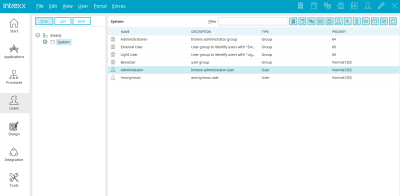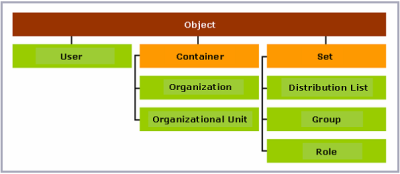Objects, Classes and Attributes
In a newly created portal, object classes will be automatically defined with mandatory attributes, such as the "User" object class with the mandatory attributes "First Name"and "Last Name". This class possesses a number of attributes with which a user can be described. There is a database field for each attrivute. Here, the values that you will enter for an object instance will be saved. You may define an unlimited number of additional attributes for an object class; however, the mandatory attributes of a class may not be changed. Objects (such as a portal user based on the "Users" class) will be created based on object classes. Object classes can be viewed as a type of template for the objects. The specific values of an object will be saved in the attributes. The object classes "Object", "Container", and "Set" are so-called base classes. Their attributes will be inherited by the classes that are created from them. So, for example, the "User" class also possesses attributes of the base class "Object", from which it is derived, in addition to its own attributes. In the following image you will see a diagram of the object class hierarchy in the Intrexx User Manager.
Every object in the tree, which depicts the structure of the user objects, can be assigned to other objects either via drag & drop or via the menu item Move.
Object class
This class is the base class for all object classes in the User Manager. Therefore, all other object classes possess every attribute of the "Object" class.
User class
This class is directly derived from the base class "Object" and represents the individual users of the portal.
Container class
This class is the base class of the object classes
-
Organisation
For objects that represent an organization or a business
-
Organizational unit
For objects that represent organizational units
With objects of these classes, other objects can be grouped in a 1:n relationship. This means, for example, that "Guitarstore" as an "Organization" object may contain the "Management" organizational unit. Likewise, for example, each employee ("Users" object) may only be assigned to one organization, one organizational unit, or one role.
Set class
This class is the base class of the object classes
-
Distribution lists
For objects that represent a distribution list
-
Group
For objects that represent groups
-
Role
For objects that describe specific roles in an organization
With the "Set" class, a m:n relationship can be created. This means, for example, a user may be both a member of the group object "Press" as well as the group object "Partners".
Creating a new class
In the Schema Manager, which you can reach from the menu User / Schema Manager, you have the ability to define your own object classes.

